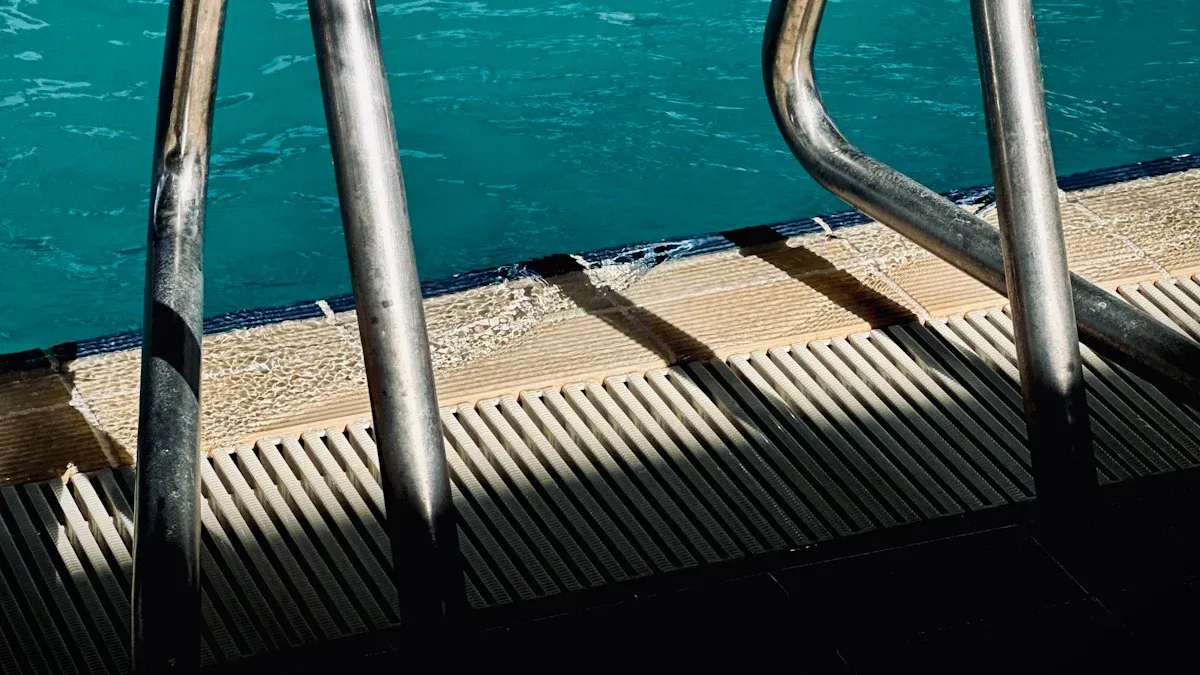Top Pool Maintenance Tips for 2025

Maintaining your pool through regular pool maintenance keeps it safe, clean, and saves money. In 2025, new tools like AI robotic cleaners make pool maintenance easier than ever. Consistent care prevents expensive repairs and ensures the water remains clear. It also benefits the environment by reducing waste and energy use. For instance, effective pool maintenance can significantly cut yearly costs, which usually range from $3,030 to $5,995.
Key Takeaways
Skim and clean your pool often to keep water clear and protect the filter.
Check and adjust chemical levels every week to keep swimming safe and stop algae.
Use energy-saving tools, like pumps with different speeds, to save money and help the planet.
Daily and Weekly Pool Maintenance
Skimming and Removing Debris
Cleaning debris from your pool is very important every day. Use a skimmer net to pick up leaves, bugs, and trash floating on the water. This stops the filter system from getting clogged and keeps the water clear. Check the skimmer and pump baskets daily to make sure they are not blocked. If they are blocked, it can damage the filter system and cost a lot to fix. At night, cover your pool to keep out debris and protect it from sun damage.
Brushing Walls and Vacuuming
Brush your pool walls and steps once a week to stop algae and dirt from building up. Use a brush that matches your pool’s surface, like concrete, vinyl, or fiberglass. After brushing, vacuum the pool floor to clean up any dirt that has sunk to the bottom. This keeps your pool clean and helps the filter work better. Regular brushing and vacuuming make your pool safe and fun to use.
Cleaning and Inspecting the Filter
The pool filter is very important for keeping the water clear. Check the filter every week and clean it if needed by following the instructions. A dirty filter can slow water flow and make the water cloudy. Look at the filter gauge to see if cleaning is required. Keeping the filter clean helps your pool stay clear and prevents equipment problems.
Monitoring and Adjusting Water Levels
The right water level is key to good pool care. Check the water level every day to make sure it is high enough for the skimmers to work. If the water is too low, it can harm the pump. If it is too high, it can mess up the pool’s chemicals. Fix the water level as needed, especially after rain or lots of swimming. Watching the water level helps avoid repairs and keeps your pool working well.
Seasonal Pool Maintenance
Winterizing Your Pool
Getting your pool ready for winter stops freezing damage. Follow these steps to protect it:
Clean the pool to remove dirt and leaves.
Test and balance the water's chemical levels.
Lower the water level to avoid freezing issues.
Add special winter chemicals to keep the water safe.
Drain pumps, filters, and other pool equipment.
Cover the pool tightly with a strong winter cover.
Check the cover often to make sure it stays secure.
These steps keep your pool safe during cold weather.
Preparing for Spring Opening
Spring is when you get your pool ready to use again. Start by taking off the winter cover and cleaning out debris. Then, do the following:
Shock the pool to kill germs, then add algae treatment.
Add enzymes to break down dirt and help sanitizers work.
Test and balance the water for safe swimming.
These steps will make your pool clean and ready for fun in warm weather.
Summer Pool Care Checklist
In summer, pools are used a lot, so care is key. Use this checklist to keep your pool in great shape:
Test the water weekly to check chemical levels.
Adjust pH and sanitizer levels if needed.
Clean filters and skimmer baskets every week.
Remove leaves and trash from the water daily.
Check water levels after heavy use and refill if needed.
Doing these tasks keeps your pool safe and fun all summer.
Fall Cleanup and Maintenance
Fall is when you prepare your pool for winter. Start by clearing out leaves and dirt to avoid stains. Balance the water's pH and sanitizer levels. Lower the water level and drain equipment to stop freezing damage. Put winter plugs in skimmers and return lines. Cover the pool tightly and check the cover often. These steps make winter prep easier and protect your pool.
Chemical Balancing and Testing
Important Chemical Levels to Check
Keeping the right chemical levels makes your pool safe and clean. Here are the main ones to check:
Chlorine: Kills germs and stops algae from growing.
pH Balance: Protects pool parts and keeps swimmers comfortable.
Algaecides: Prevents algae before it becomes a big issue.
Calcium Hardness: Stops damage to pool surfaces and equipment.
Shock Treatments: Removes dirt and helps chlorine work better.
Cyanuric Acid: Protects chlorine from breaking down in sunlight.
Water Clarifiers: Clears water by getting rid of tiny particles.
Testing often helps you keep these levels right and avoid problems.
Easy Ways to Test Pool Water
Testing pool water is easy with the right tools. Use strips or liquid kits to check pH, chlorine, and more. Dip the strip or take a sample, then match it to the guide. Test every week or after lots of swimming to keep balance. For better accuracy, take a sample to a pool store.
Handling Pool Chemicals Safely
Using pool chemicals carefully keeps you and your pool safe. Follow these steps:
Store chemicals in a cool, dry place with air flow.
Keep lids closed and containers upright.
Never mix different chemicals together.
Wear gloves and goggles when using them.
Read instructions before using any chemical.
Rinse empty containers before throwing them away to avoid accidents.
Fixing Common Chemical Problems
Chemical issues can cause cloudy water or algae. If water is cloudy, check the filter and fix pH levels. For algae, scrub the spots and use a shock treatment. Regular testing and fixing stops these problems and keeps your pool clean.
Tip: Keeping chemicals balanced is very important for pool care.
Equipment Maintenance and Upgrades
Checking Pumps and Filters Regularly
Frequent checks help your pool equipment last longer. Follow these steps:
Take out the filter cartridge from its holder.
Wash the cartridge with a garden hose from top to bottom.
Soak it in a cleaning solution for a deeper clean.
Let it dry fully before putting it back.
Check skimmer baskets and pumps weekly to stop clogs. Look at filters, heaters, and pumps monthly for damage or wear. Clean filters by backwashing or using a cartridge cleaner. Seasonal checks prepare your equipment for spring and protect it in fall. These steps keep your equipment working well and lower repair costs.
Cleaning and Changing Pool Tools
Dirty or broken tools can hurt your pool’s performance. Wash nets and brushes after each use to stop algae growth. Replace broken items like cracked hoses or damaged vacuum heads quickly. For bigger equipment like pumps, follow the maker’s cleaning and replacement instructions. Taking care of your tools keeps your pool safe and working properly.
Energy-Saving Pool Systems
Switching to energy-saving systems helps save money and the planet. Variable-speed pumps use up to 80% less energy than old single-speed pumps. They are quieter and cut down on harmful emissions. Some areas give rebates for Energy Star-certified models, making them cheaper to buy. Over time, these systems save you money and make pool care more eco-friendly.
Smart Pool Technology in 2025
Smart tech makes pool care easier than ever. Cloud-based tools let you control water and temperature from your phone. Automatic covers save water and reduce chemical use. Robotic cleaners pick up debris with little effort. Here are some cool trends:
Trend | What It Does |
|---|---|
Better Pool Cleaning | Robots and app-connected systems make cleaning faster and easier. |
Green Pool Options | Solar heaters and saltwater systems are eco-friendly choices. |
Subscription Services | Regular cleaning plans with set prices make upkeep simple. |
New Rules | Stricter water quality laws make pools safer for everyone. |
These new tools and ideas make pool care simpler, greener, and more efficient.
Eco-Friendly and Cost-Effective Pool Maintenance
Benefits of Solar Covers and Heaters
Solar covers and heaters are great for saving energy. A solar cover stops water from evaporating, keeping levels steady. It also uses sunlight to warm the pool, cutting heating costs. Solar heaters let you swim longer without raising energy bills. These systems use renewable energy, which is better for the planet. By choosing solar options, you save money and help the environment.
Reducing Water Waste
Saving water is important for eco-friendly pool care. Check for leaks often to stop water loss. Use a pool cover to keep water in and dirt out. This means less cleaning and fewer chemicals. Keep water at the right level to avoid splashing and spills. Adjust your filter system to reduce backwashing. For extra savings, recycle pool water with reverse osmosis. These tips save water and lower your bills.
Choosing Sustainable Cleaning Products
Eco-friendly cleaning products are safer for pools and nature. They break down naturally and don’t harm animals or plants. These products leave no harmful chemicals behind, keeping swimmers safe. While they may cost more at first, they last longer and save money. They also protect pool equipment from damage caused by strong chemicals.
Tips for Lowering Energy Costs
Cut energy costs with smart upgrades. Use a variable-speed pump to save power. A good pool cover keeps heat in and water from evaporating. Robotic cleaners make cleaning easier and use less energy. Switch old lights to LED ones to save electricity. These changes make your pool cheaper to run and better for the planet.
Taking care of your pool often keeps it safe and clean. Regular checks help water stay clear and equipment work well. Using eco-friendly items like solar covers saves money and helps nature. Smart pool tools make caring for your pool easier and faster. Try these tips now to enjoy your pool more!
FAQ
How often should you test your pool water?
Test your pool water once every week. After rain or heavy swimming, test it more often to keep it balanced.
What is the best way to prevent algae growth?
Brush the pool walls weekly to stop algae buildup. Use algaecides regularly and keep chlorine levels correct. Clean out debris often to avoid algae problems.
Can you save money with energy-efficient pool systems?
Yes! Energy-saving tools like LED lights and variable-speed pumps use less power. They cut costs and are better for the planet.
Tip: Regular care and smart upgrades make your pool cheaper to maintain.
See Also
Why Hot Tub Maintenance Matters More Than Ever in 2025
Why You Should Prioritize Garage Door Care This Year
Essential Advice for Selecting Garage Door Professionals in 2025
The Role of Routine Pest Control in Home Safety and Health
Your Comprehensive Resource for Locating a Trustworthy Handyman
